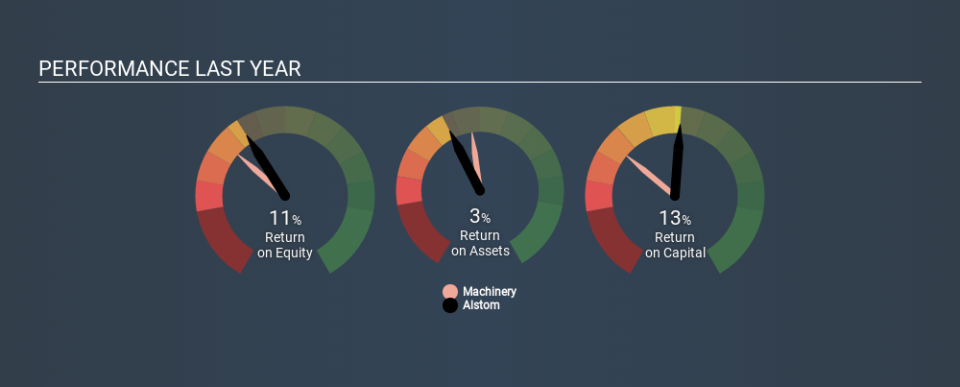Is Alstom SA's (EPA:ALO) Capital Allocation Ability Worth Your Time?

Today we are going to look at Alstom SA (EPA:ALO) to see whether it might be an attractive investment prospect. Specifically, we're going to calculate its Return On Capital Employed (ROCE), in the hopes of getting some insight into the business.
Firstly, we'll go over how we calculate ROCE. Second, we'll look at its ROCE compared to similar companies. Then we'll determine how its current liabilities are affecting its ROCE.
What is Return On Capital Employed (ROCE)?
ROCE is a measure of a company's yearly pre-tax profit (its return), relative to the capital employed in the business. Generally speaking a higher ROCE is better. Overall, it is a valuable metric that has its flaws. Renowned investment researcher Michael Mauboussin has suggested that a high ROCE can indicate that 'one dollar invested in the company generates value of more than one dollar'.
So, How Do We Calculate ROCE?
The formula for calculating the return on capital employed is:
Return on Capital Employed = Earnings Before Interest and Tax (EBIT) ÷ (Total Assets - Current Liabilities)
Or for Alstom:
0.13 = €576m ÷ (€13b - €8.4b) (Based on the trailing twelve months to September 2019.)
So, Alstom has an ROCE of 13%.
View our latest analysis for Alstom
Does Alstom Have A Good ROCE?
ROCE can be useful when making comparisons, such as between similar companies. Using our data, Alstom's ROCE appears to be around the 11% average of the Machinery industry. Independently of how Alstom compares to its industry, its ROCE in absolute terms appears decent, and the company may be worthy of closer investigation.
Our data shows that Alstom currently has an ROCE of 13%, compared to its ROCE of 6.0% 3 years ago. This makes us wonder if the company is improving. You can click on the image below to see (in greater detail) how Alstom's past growth compares to other companies.
It is important to remember that ROCE shows past performance, and is not necessarily predictive. ROCE can be deceptive for cyclical businesses, as returns can look incredible in boom times, and terribly low in downturns. This is because ROCE only looks at one year, instead of considering returns across a whole cycle. Since the future is so important for investors, you should check out our free report on analyst forecasts for Alstom.
Alstom's Current Liabilities And Their Impact On Its ROCE
Current liabilities are short term bills and invoices that need to be paid in 12 months or less. Due to the way the ROCE equation works, having large bills due in the near term can make it look as though a company has less capital employed, and thus a higher ROCE than usual. To counteract this, we check if a company has high current liabilities, relative to its total assets.
Alstom has total liabilities of €8.4b and total assets of €13b. Therefore its current liabilities are equivalent to approximately 64% of its total assets. This is admittedly a high level of current liabilities, improving ROCE substantially.
Our Take On Alstom's ROCE
While its ROCE looks decent, it wouldn't look so good if it reduced current liabilities. Alstom shapes up well under this analysis, but it is far from the only business delivering excellent numbers . You might also want to check this free collection of companies delivering excellent earnings growth.
If you are like me, then you will not want to miss this free list of growing companies that insiders are buying.
If you spot an error that warrants correction, please contact the editor at editorial-team@simplywallst.com. This article by Simply Wall St is general in nature. It does not constitute a recommendation to buy or sell any stock, and does not take account of your objectives, or your financial situation. Simply Wall St has no position in the stocks mentioned.
We aim to bring you long-term focused research analysis driven by fundamental data. Note that our analysis may not factor in the latest price-sensitive company announcements or qualitative material. Thank you for reading.

 Yahoo Finance
Yahoo Finance 
